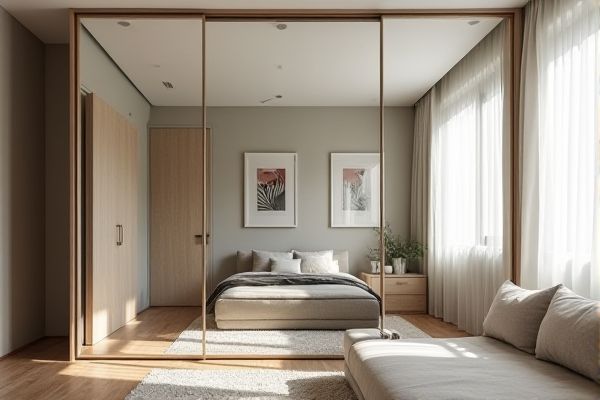
Closet mirrors offer a versatile and easily movable solution to brighten your room and provide full-length reflection, while mirrored doors maximize space efficiency by integrating the mirror directly into your closet design. Discover which option best suits your style and space needs in the rest of the article.
Table of Comparison
| Feature | Closet Mirror | Mirrored Doors |
|---|---|---|
| Space Efficiency | Requires additional wall space | Built-in, saves room |
| Installation | Easy, standalone installation | Complex, door replacement needed |
| Aesthetic Appeal | Offers flexibility in style and placement | Creates seamless, modern look |
| Functionality | Primarily for reflection | Combines functionality of doors and mirrors |
| Cost | Generally lower cost | Usually higher cost due to custom fit |
| Maintenance | Easy to clean and replace | Requires careful cleaning and maintenance |
Closet Mirror vs Mirrored Doors: An Overview
Closet mirrors provide a standalone reflective surface ideal for quick outfit checks and decor enhancement, while mirrored doors integrate functionality with space-saving design by combining storage access and full-length reflection. Mirrored doors maximize room brightness and create an illusion of expanded space, making them a popular choice for smaller bedrooms or walk-in closets. The decision between closet mirrors and mirrored doors hinges on space availability, aesthetic preference, and budget considerations.
Design Aesthetics: Style Comparisons
Closet mirrors offer a sleek, standalone design that enhances room depth and light reflection, often serving as a focal decorative piece. Mirrored doors integrate functionality with aesthetics, providing a seamless, modern look by combining storage solutions with reflective surfaces. Your choice affects the room's style, where mirrors contribute elegance and mirrored doors emphasize streamlined, contemporary design.
Space Enhancement and Light Reflection
Closet mirrors expand your room visually by creating an illusion of more space, making even smaller areas feel open and airy. Mirrored doors not only reflect light throughout the room but also maximize functional space by combining storage with a sleek reflective surface. Both options enhance brightness and depth, but mirrored doors offer a seamless, space-saving design ideal for modern interiors.
Installation Processes and Requirements
Closet mirror installation typically involves mounting a single large panel which requires secure wall anchors and precise alignment to avoid damage or misplacement. Mirrored doors demand a more complex setup, including track systems and hardware that ensure smooth sliding or swinging functionality, often necessitating professional adjustments. Your choice depends on the available space and whether you prioritize simplicity or integrated design in your closet setup.
Cost Differences Explained
Closet mirrors typically involve installing a standalone reflective surface, often costing between $50 and $200 depending on size and frame style. Mirrored doors, integrated as part of sliding or hinged closet systems, generally range from $150 to $500 due to custom fitting, hardware, and door materials. The price difference is mainly influenced by installation complexity, materials used, and whether the mirror is a simple panel or incorporates functional closet components.
Durability and Maintenance
Closet mirrors offer high durability with solid glass panels that resist scratches and chips, requiring only regular cleaning with glass cleaner to maintain clarity. Mirrored doors typically feature tempered glass for added strength, but their frames and sliding mechanisms demand periodic adjustment and lubrication to prevent wear and ensure smooth operation. Both options provide reflective surfaces, yet closet mirrors generally require less maintenance over time compared to the mechanical upkeep associated with mirrored door systems.
Functionality and Everyday Use
Closet mirrors offer a standalone reflective surface that can be positioned anywhere in a room, providing flexibility for daily dressing and outfit checks. Mirrored doors combine storage and mirror functionality in one, saving space by eliminating the need for separate mirrors while allowing easy access to clothing and accessories. Both enhance room aesthetics and light reflection, but mirrored doors streamline organization and daily routines by integrating two functions into a single design element.
Safety Considerations
Closet mirrors offer a straightforward reflective surface but may pose safety risks if not tempered or securely mounted, increasing the chance of breakage and injury. Mirrored doors often use safety glass designed to resist shattering, providing enhanced protection in high-traffic areas. Assess your space carefully to ensure your choice supports both aesthetics and your safety requirements.
Customization and Versatility
Closet mirrors offer extensive customization options, allowing you to select frame styles, sizes, and mounting methods tailored to your specific space and decor preferences. Mirrored doors provide versatile functionality by combining storage access with reflective surfaces, optimizing room light and creating an illusion of greater space. Your choice depends on whether you prioritize personalized design flexibility or seamless integration with existing closet systems.
Choosing the Best Option for Your Space
Closet mirrors provide a versatile and easily adjustable solution that enhances natural light and makes your room appear larger, ideal for smaller spaces or rented homes. Mirrored doors save floor space by integrating reflective surfaces directly into the closet design, offering a sleek, modern look while providing functionality in compact rooms. Your choice depends on whether you prioritize flexibility and ease of installation or a streamlined, space-saving design.
 homyna.com
homyna.com